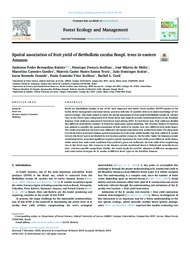Spatial association of fruit yield of Bertholletia excelsa Bonpl. trees in eastern Amazon.
Spatial association of fruit yield of Bertholletia excelsa Bonpl. trees in eastern Amazon.
Author(s): BATISTA, A. P. B.; SCOLFORO, H. F.; MELLO, J. M.; GUEDES, M. C.; TERRA, M. C. N. S.; SCALON, J. D.; GOMIDE, L. R.; SCOLFORO, P. G. V.; COOK, R. L.
Summary: Brazil nut (Bertholletia excelsa) is one of the most important non-timber forest product (NTFP) species in the world. Better management and conservation practices will only be possible with an in-depth knowledge of tree species ecology. This study aimed to assess the spatial association of fruit yield of Bertholletia excelsa (B. excelsa) trees in two forest types (old growth terra firme forest and Amazon-cerrado transitional forest) in the Brazilian Amazon. Fruit yield was measured in both forest types during 2010. At each forest type, fruit yield was divided into different yield classes (number of fruits) for subsequent spatial modeling. The bivariate Ripley?s K-function was applied to quantify the spatial association of fruit yield of B. excelsa trees over different fruit yield classes. The results revealed that the forest type influences the spatial association of B. excelsa fruit yield. The old growth terra firme forest presented random spatial association for fruit yield, which implies that fruit yield of B. excelsa trees in this forest type is not limited by tree location and site resources. On the other hand, the Amazon-cerrado transitional forest presented significant negative spatial association for fruit yield across different yield classes, which means that under some conditions fruit yield of a given tree influences the fruit yield of the neighboring tree in this forest type. Site resources in the Amazon-cerrado transitional forest is limited and naturally favors inter- and intra-specific competition. Finally, the results imply the need for adoption of different management and conservation strategies for B. excelsa in different forest types in the Brazilian Amazon.
Publication year: 2019
Types of publication: Journal article
Unit: Embrapa Amapá
Observation
Some of Embrapa's publications are published as ePub files. To read them, use or download one of the following free software options to your computer or mobile device. Android: Google Play Books; IOS: iBooks; Windows and Linux: Calibre.
Access other publications
Access the Agricultural Research Database (BDPA) to consult Embrapa's full library collection and records.
Visit Embrapa Bookstore to purchase books and other publications sold by Embrapa.

